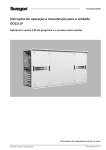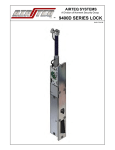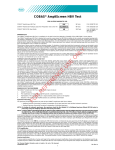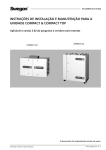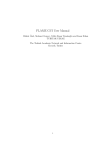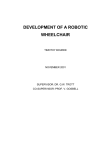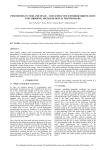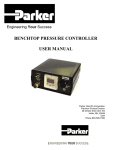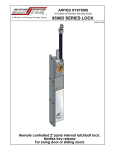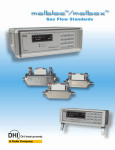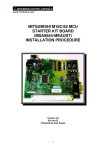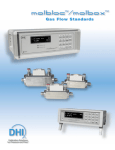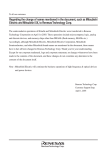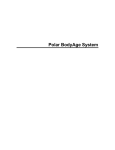Download EIS-project 2000
Transcript
Project Report Telemedicin enabled mobile pulse and blood pressure sensor Ana Belén Cabrerizo Tobias Bergström Anna Carlsson Ingemar Edin Erkan Emin Mattias Enstedt Martin Ernst Ana Isabel Carro Svante Johansson Thomas Könberg Erik Larsson Magnus Lundberg Jonas Melin Kaveh Nadi Erik Svedbäck Per Svensson Jonas Örnehag Department of Computer Science and Electrical Engineering Division of Industrial Electronics Luleå University of Technology Industrial Electronics EIS-project 2000 1999-05-20 1 ABSTRACT The last course, in the MSc in Electrical Engineering – Industrial Electronics, at Luleå University of Technology, is a project course. This year the goal was to produce a blood pressure and pulse measurement device. It was supposed to be used in elderly care since it is an inconvenience for them to have to go to a hospital just to measure their pulse and blood pressure. With this device these measurements can be made in their home environment which would help them to relax and make the measurement more accurate. A doctor would also be relieved of a lot of work since he would be able to run measurements parallel with other work and then come back to analyse them at a later point. It would also be easier to compare with previous measurements since it would be possible to store the measurements from each patient on “their own” homepage. The device is built around a Mitsubishi processor, M16C/62, and it communicates with Internet via Ethernet and Bluetooth. The report describes how the problems were solved and what was produced by the groups in the different areas such as the processor, electromechanics, user interface and Bluetooth. Antenna AB was our partner in working with this project. Luleå University of Technology Industrial Electronics EIS-project 2000 1999-05-20 2 FOREWORD The aim of the project course is to develop better ability to formulate and solve technical problems, both independently and as a group. Together with knowledge from earlier courses a deeper knowledge in basic principles and an overview of the area of computer science and electrical engineering, is striven for. The course should also develop and improve the technique of presentation. We were seventeen students taking the project course this year and the idea was to do something with Embedded Internet Systems (EIS). We wanted to do the project working towards a company since we figured it would add more inspiration to the work and therefore we begun searching for an interesting partner on the fall of 1999. The project started in January 2000 in co-operation with Antenna AB. The objective was to build a blood pressure measurement device that could communicate with Internet. Magnus Ek at Antenna came up with a specification and after some changes to make it fit us better we had the specification to use in our project. We would like to thank all persons involved, especially Magnus Ek at Antenna AB and the following persons: Anders Pettersson, Master thesis student at Luleå University of Technology Jan Johansson, Antenna AB Jonas Andersson, Antenna AB Jerker Delsing, Luleå University of Technology Sven Molin, Luleå University of Technology Lewi Lindqvist, Luleå University of Technology Kenneth Hartvik, Luleå University of Technology Kalevi Hyyppä, Luleå University of Technology Peter Widetun, Abelko Innovation AB Thord Isaksson, Abelko Innovation AB Magnus grandmother, for helping us out as a model Luleå University of Technology Industrial Electronics EIS-project 2000 1999-05-20 INTRODUCTION Antenna AB, is a Swedish electronics firm situated in Kalix with 15 years of experience in designing radio and telecommunications products and systems. The Antenna Group has two business areas, Antenna Care and Antenna Research & Development. Antenna Care develops, produces and markets Care Systems and Carephones for elderly and handicapped people. Antenna Development is a consulting company within radio applications and telecommunication. Activities include contract assignments for the electronic industry in the area of telecommunications as well as development of our own products within the Antenna group, mainly personal safety systems. Their interest in the concept of Bluetooth and how they could integrate that in their products, both new and old lead to this project. 3 Luleå University of Technology Industrial Electronics EIS-project 2000 1999-05-20 4 GENERAL DESCRIPTION With Internet in almost every home now, a lot of interesting new concepts opens in the area of medical treatment. There are a lot of small things that elderly people might find annoying and we thought one of them is the trips they have to take to the doctor just to check their blood pressure. It takes them almost a whole day to get there and back sometimes just to make such a simple medical examination. There ought to be a way of doing these tests without having to go to the hospital and a doctor. With the new Bluetooth technology there is also a tool to avoid annoying cables and to have to be on the same place for each measurement. The device makes it possible to stay at home and perform your everyday chores if you want to and then at a certain hour you sit down in your own comfortable chair and relax while the doctor performs the measurement from his office. There are two different types of measurements that can be performed, either a single measurement at any hour or a continuous measurement with a number of measurements during the whole day. The pulse often changes during different hours of the day since you are more active on certain times than others hence making a number of measurements is the preferred method since it gives a more accurate material for comparing the pulse with previous measurements. Two examples of when this device could be of good use is: ♦ When a patient is being released from hospital he/she has been there a few days just so that the pulse and blood pressure can be monitored and made sure to be all right. With this device it would be possible to send them home earlier, a relief both for the patient and the hospital economy. It assumes that the patient have got Internet access at home. ♦ It could also be very useful in homes for the elderly. The doctor could instruct a nurse on location on which patient he wants to make the measurement on a particular day, for example by phone or e-mail, and the nurse could assist the patient in getting the device ready. Moreover the use of Internet technology can be of interest because of ♦ Well known and spread technology; no need to reinvent the wheel. Luleå University of Technology Industrial Electronics EIS-project 2000 1999-05-20 5 ♦ Ability to use available infrastructure, such as Ethernet networks in buildings. No need for new wires. ♦ With WWW- or FTP-technology you do not have to write client software, and become platform independent. ♦ Enables long distance access or surveillance. ♦ Enables easy software updates. (If using flash memory.) The block diagram below describes the system built The measurement system Bloodpressurecuff Measurement device Bluetooth Air Ethernetbridge Bluetooth Ethernet ethernetcable Computer WWW The device is based on a micro controller from Mitsubishis M16C62 series. For measuring the pulse and blood pressure Motorola has a device, MPX50500P, that is used. A pump from Aldax constructed for these applications complemented with a valve from Pneutronics completes our actual measurement device. The Internet communication uses an Ethernet chip from Cirrus Logic and the Bluetooth module from Ericsson. The M16C62 has 256kB flash memory and 20kB RAM built-in. The hardware design of the Bluetooth-Ethernet bridge is based on a serial-Ethernet bridge, designed by Anders Petterson LTU. The serial interface on that bridge has been changed to a Bluetooth interface using the Uart 0 transceiver on the processor and the Uart transceiver on the Bluetooth module. The hardware is implemented on a four layer PCB and is powered with 3.3 volts. The radio signal is transmitted via an inverted F-antenna. The system is also equipped with a real time clock, a liquid crystal display and serial communication ports. Luleå University of Technology Industrial Electronics 1 2 3 4 5 6 7 EIS-project 2000 1999-05-20 6 Terminology ........................................................................................................................................7 The processor.....................................................................................................................................8 2.1 Usage..............................................................................................................................................9 2.2 Real time clock ................................................................................................................................9 2.3 Memory .........................................................................................................................................10 2.3.1 Serial E2PROM ......................................................................................................................10 2.4 Interfacing the real time clock and the E2PROM using I2C............................................................11 2.5 LCD display ...................................................................................................................................12 2.6 Processor setup ............................................................................................................................12 2.7 Software ........................................................................................................................................12 2.7.1 Device drivers and tasks ........................................................................................................13 2.7.2 RTXC Adaptation ...................................................................................................................14 2.7.3 Priorities .................................................................................................................................15 2.8 RTXC ............................................................................................................................................15 2.8.1 Why did we choose a RTOS? ................................................................................................15 2.8.2 The RTOS – RTXC ................................................................................................................15 Pressure and pulse measurement ....................................................................................................16 3.1 Introduction ...................................................................................................................................16 3.1.1 The oscillometric method .......................................................................................................16 3.2 Measurement procedure ...............................................................................................................16 3.3 Hardware.......................................................................................................................................17 3.3.1 Arm cuff..................................................................................................................................17 3.3.2 Box .........................................................................................................................................18 3.3.3 Pump......................................................................................................................................18 3.3.4 Pressure sensor .....................................................................................................................19 3.3.5 Filter .......................................................................................................................................19 3.3.6 Battery....................................................................................................................................21 3.3.7 Air valve .................................................................................................................................21 3.3.8 Transistors .............................................................................................................................21 3.3.9 Voltage converters .................................................................................................................22 3.3.10 Summer ..............................................................................................................................22 3.3.11 Buttons ...............................................................................................................................22 3.4 Software for the measurement ......................................................................................................22 Ethernet ............................................................................................................................................24 4.1 Ethernet Hardware. .......................................................................................................................24 4.2 Ethernet Software. ........................................................................................................................24 Bluetooth...........................................................................................................................................25 5.1 Bluetooth protocol. ........................................................................................................................25 5.2 Bluetooth device driver..................................................................................................................25 5.2.1 The PBPS-protocol ................................................................................................................26 5.2.2 Functional description ............................................................................................................29 User manual .....................................................................................................................................29 6.1 User interface................................................................................................................................29 6.1.1 Start a manual measurement sequence ................................................................................30 6.1.2 Start a remote-controlled measurement sequence ................................................................31 6.2 The ELTEK health monitoring manual for windows ......................................................................32 6.2.1 Getting started .......................................................................................................................32 6.2.2 Making a single measurement ...............................................................................................33 6.2.3 Multiple measurements ..........................................................................................................33 6.2.4 Battery check and Bluetooth link status .................................................................................34 6.2.5 Disconnection and reset ........................................................................................................35 6.2.6 Remember .............................................................................................................................36 6.2.7 Problems ................................................................................................................................36 Appendix 1 LCD functional description .............................................................................................37 Luleå University of Technology Industrial Electronics 1 EIS-project 2000 1999-05-20 TERMINOLOGY ALU CGI CMOS CRC DBP DMA EEPROM FPGA HTML IP IPX LAN LCD M16C RAM RLE RTC RTOS RTXC SBP SRAM SSI Arithmetic Logic Unit Common Gateway Interface Complementary Metal Oxide Semiconductor Cyclic Redundancy Check Diastolic Blood Pressure Direct Memory Access Electrically Erasable Programmable Read Only Memory Field Programmable Gate Array HyperText Markup Language Internet Protocol Internet Packet Exchange Local Area Networking Liquid Crystal Display Microcontroller Mitsubishi M16C60/61/62 Random Access Memory Run Length Encoding Real Time Clock Real Time Operating System The RTOS used Systolic Blood Pressure Static Random Access Memory Server Side Include 7 Luleå University of Technology Industrial Electronics 2 EIS-project 2000 1999-05-20 8 THE PROCESSOR The M16C/62 group of single-chip microcomputers from Mitsubishi are built using the high-performance silicon gate CMOS process using a M16C/60 Series CPU core and are packaged in a 100-pin plastic moulded QFP. These microcomputers operate using sophisticated instructions featuring a high level of instruction efficiency. Due to the 1M bytes of address space, they are capable of executing instructions at high speed. The built-in multiplier and DMAC make them ideal for controlling office, communications, industrial equipment, and other high-speed processing applications. The M16C/62 has a wide range of built-in peripheral devices, such as A-D converter, D-A converter, timers, UART and CRC calculation circuit. Fig. 2.1 shows the blockdiagram of the M16C/62 group. Fig. 2.1 Block-diagram of the M16C/62 group. The M30624FGLFP is the CPU used in this project. Is has 256KB FLASH ROM, 20KB RAM and are using a 3.3V supply voltage. This one is ideal to be used in an embedded system and the low power consumption is important in this application. Luleå University of Technology Industrial Electronics 2.1 EIS-project 2000 1999-05-20 9 USAGE To set up the microcontroller many things has to be considered. To make the equipment as small as possible as many built-in devices should be used. This will also make the equipment as cheep as possible. 2.2 REAL TIME CLOCK The PCF8563 is a CMOS real-time clock/calendar optimised for low power consumption. A programmable clock output, interrupt output and voltage-low detector is also provided. All address and data are transferred serially via a two-line bidirectional I2C-bus. Maximum bus speed is 400 kbits/s. The built-in word address register is incremented automatically after each written or read data byte. Provides year, month, day, weekday, hours, minutes and seconds based on 32.768 kHz quartz crystal. As is shown in its block-diagram below the PCF8563 contains sixteen 8-bit registers with an auto-incrementing address register, an on-chip 32.768kHz oscillator with an integrated capacitor, a frequency divider which provides the source clock for the realtime Clock (RTC), a programmable clock output, a timer, an alarm, a voltage-low detector and a 400kHz I2C-bus interface. Fig. 2.2.1 Block-diagram of the PCF8563 group. All 16 registers are designed as addressable 8-bit parallel registers although not all bits are implemented: - The first two registers (memory addresses 00H and 01H,called in the figure 0 and 1), are used as control and/or status registers. - The memory addresses 02H through 08H are used as counters for the clock function (seconds, minutes, hours, days, weekdays, months/century and years). Except the weekdays register, the rest are coded in BCD format, for example the month assignment for January is 00001 and for May is 00101. Luleå University of Technology Industrial Electronics 2.3 EIS-project 2000 1999-05-20 - Address locations 09H through 0CH contain alarm registers, which define the conditions for an alarm. - Address 0DH controls the CLKOUT output frequency. - 0EH and 0FH are the timer control and timer registers, respectively. 10 MEMORY If there is no Bluetooth connection we have to be able to store the measurements done during that time. Therefore we added an E2PROM. If the measurements had been stored in RAM, the data would have been lost in the case of a power failure, this is not true for the E2PROM which retains data during a power down. The E2PROM should be able to store at least 48 measurements (one measurement each hour during 48 hours), but we have a large margin in this case. 2.3.1 Serial E2PROM In this project we have used an E2PROM called X24C16, which is a CMOS 16.384 bit serial E2PROM, internally organised 2048 x 8. The X24C16 features a serial interface and software protocol allowing operation on a simple two-wire bus. One of this E2PROM's features is that it has a low power consumption and that is of high priority in our case. The X24C16 is fabricated with Xicor's advanced CMOS Textured Poly Floating Gate Technology. The X24C16 utilises Xicor's proprietary Direct Write TM cell providing a minimum endurance of 100 000 cycles and a minimum data retention of 100 years. Fig. 2.2.2 Functional-diagram of the X24C16. Luleå University of Technology Industrial Electronics 2.4 EIS-project 2000 1999-05-20 11 INTERFACING THE REAL TIME CLOCK AND THE E2PROM USING I2C The I2C bus is a multi-master bus communications inter-IC control protocol developed by Phillips that is now used by many IC’s. An I2C bus mode provides efficient control between IC’s. It is a two-way bus line with a simple two-wire structure consisting of a serial data line (SDA) and a serial clock line (SCL). In our case the Processor is configured to be the only master and the RTC and EEPROM works as slaves. Fig. 2.4.1 shows the interface for the RTC and E2PROM using I2C. EEPROM RTC SCL M16C SDA Fig. 2.4.1 The interface over the RTC and E2PROM using I2C The bitstream on the SDA line during a write cycle to the RTC and E2PROM is shown in the figure bellow Fig. 2.4.2 Master Transmits to slave receiver Where: -S is the Start condition, which is a high to low transition of SDA when SCL is high. -SLAVE ADDRESS is the seven bits, which correspond to the RTC or E2PROM address (depending on the device that is working as slave). - R / W is bit of the salve address which set the write or read mode. -WORD ADDRESS is the byte that defines which register is to be accessed. -A is the acknowledge bit that is used to indicate successful data transfer. -DATA is the output data byte. -P is the Stop condition, which is a low to high transition of SDA when SCL is high. Luleå University of Technology Industrial Electronics 2.5 EIS-project 2000 1999-05-20 12 LCD DISPLAY The LCD display is capable of 8x2 characters and has a fontsize of 5*7 dots. The first display we ordered was a Optrex DMC 50448. It worked on the starterkit (Mitsubishi MSA0654-G01) but unfortunately it broke and we tried to order a new one from Elfa, but they did not have any in stock. Instead they recommended a LSS3H202XA from ALPS which was supposed to be equivalent with the Optrex model. The ALPS display did not come with any manual, but we figured out that it would work with the device driver written for the Optrex. We have however not been able to get it to work, even though the device driver has been checked with a logic analyser, and it is correct if compared with instructions in the Optrex manual. A functional description of the display is available in appendix 1. 2.6 PROCESSOR SETUP These are the pins that must be set up the right way to get the processor to work in the correct mode in our application: Single chip mode, because we do not have any external memory using the external data and address bus. CNVss Pull down BYTE Pull down. AVcc AVss /RDY + 3.3 V Ground Pull up /NMI Pull up /Hold Reset Pull up Pull up Table 2.5.1 2.7 Selects processor mode, connected to Vss to set up processor in Single chip mode. Selects the width of the external data bus. Should be connected to Vss when operating in single chip mode. Analog power supply input Analog power supply input Not used in single chip mode Non-Maskable Interrupt, an interrupt is generated when this pin is set to low. Not used in single chip mode A low on this input resets the processor. Set-up pins for the M16C SOFTWARE All software have been written by us, but we could use some parts of last years project, the code that came with the evaluation board and some examples for the devices used. All code is written in C and is run on top of RTXC, which is a real time operating system. The software is divided into different tasks and these are given different priorities. Luleå University of Technology Industrial Electronics 2.7.1 EIS-project 2000 1999-05-20 13 Device drivers and tasks The buttons, who are interrupt driven, signals on a semaphore that is read by the button task. The task then takes suitable action depending on the state of the measuring device. The measurement task controls the pump and the valve by turning pins on or off, 3 V or 0 V. These pins are connected to the gate of a FET transistor. The two pressure signals are read by 8 bit AD converters. The algorithms are described in 5.4 on page 23 and a brief in 5.2 on page 16. The Bluetooth task is managing all communication with the Bluetooth module. The other tasks will send their data frames to the bluetooth task when needed. When a set time command is received from Bluetooth that frame is passed on to the RTC task which can set time of day and date in the RTC. The RTC task is also responsible of providing the measurement task with time stamps for each measurement. Whenever something should be written to the display that data is sent to the display task. This task then controls the display hardware and makes sure that the messages are shown long enough and not get mixed up. More information about the display is available in section 2.5. Luleå University of Technology Industrial Electronics EIS-project 2000 1999-05-20 Bluetooth module 14 Intertaskcommunication Device driver for hardware Bluetooth task Real time clock Display task Display Button task Buttons RTC task Measuring task Pressure sensor Fig. 3.1.1 2.7.2 Valve Pump Block-scheme for the device drivers and tasks. RTXC Adaptation The code for the device drivers has been written in three stages. The first stage was to write them in pseudo-code, the next stage was to make them work on the naked processor and the last stage was to make the code run ontop of the RTXC. Step 1: Pseudo code Step 2: Convert pseudo-code to low level C-routines Step 3: Modify the low-level C-routines allowing them to run ontop of RTXC Luleå University of Technology Industrial Electronics 2.7.3 EIS-project 2000 1999-05-20 15 Priorities All the tasks need an assigned priority to work in RTXC. The priorities depend on how the tasks are supposed to work. Some tasks have to run in regular time interval, some must not be interrupted and then some can be executed when nothing else happens. Assigning priorities is a difficult thing to do. The best way to decide which priority a task must have is often to test it by running the tasks. 2.8 RTXC 2.8.1 Why did we choose a RTOS ? The system requires the following criterions: The system is under pressure of time critical events e.g. it has to be able to respond to sudden events caused by peripheral devices. Events should be able to have different priorities Resource-sharing, semaphores and time-slicing is needed Although the above requirements could be implemented separately, it is a lot easier to use a RTOS since the RTOS does include all of the above requirements. 2.8.2 The RTOS – RTXC There was no thoughts spent on which RTOS to choose since we already had a RTOS to use from last years project. The name of the RTOS is RTXC and is provided by Embedded Power. Below in table 3.1 some data about RTXC are shown. PART RTXC Kernel About 10kb Max interrupt latency Min context switch Dynamic processes Nested interrupts Multi tasking 9 cycles 91 cycles Yes Yes Pre-emptive, Round Robin, Time slicing 90 days Support Table 4.2.1 Data describing RTXC. Luleå University of Technology Industrial Electronics EIS-project 2000 1999-05-20 16 Although it is difficult to calculate the total OS overhead (processor power needed by the RTOS), we can see that the OS overhead caused by the interrupt latency and the context switch is pretty low. This is important since the OS overhead has to be as low as possible in an application where speed and time are critical. In our application we have such a situation and decided to use RTXC since it is a good RTOS for these circumstances. 3 PRESSURE AND PULSE MEASUREMENT 3.1 INTRODUCTION 3.1.1 The oscillometric method The oscillometric method for measuring the blood pressure is used by the majority of the automatic devices on the market today. The main concept of the oscillometric method is to use an inflatable cuff that surrounds the upper arm. First you inflate the cuff to a pressure above the systolic blood pressure. Then start to reduce the air pressure until the amplitude of the pressure in the cuff suddenly grows larger. This pressure is very close to the systolic blood pressure. Then continue to reduce the air pressure and the blood pressure amplitude will continue to increase until maximum amplitude is reached. After that the blood pressure amplitude will decrease rapidly. The diastolic blood pressure is taken at the end of that rapid decrease. 3.2 MEASUREMENT PROCEDURE A measurement starts with closing of the valve. Then the pump starts to inflate the cuff. When a pressure of about 200 mmHg is reached, the pump is turned off. At this time we will not be able to detect any pulse beats because the pressure in the cuff is to high to let the blood pass. The next step is to slowly let the air out by opening the valve. During the deflation we continuously measure the filtered part of the pressure signal (figure 5.2.1.) and the pressure signal directly from the pressure sensor (Figure 5.2.2.). For the signal measurement we use two AD converters on the microprocessor. Every time the filtered pressure signal exceeds a certain threshold value, we save the absolute pressure signal and the time when it occurred. After a while the pulse signal is too small to exceed the threshold value because of too low air pressure in the cuff. At this time the measurement is over. The first pressure value that was stored is the SBP and the last one is the DBP. To calculate the pulse we use the number of pulse beats and the time information for every pulse beat. We calculate the pulse by taking the number of pulses registered and divide it with the time during these pulses. Luleå University of Technology Industrial Electronics EIS-project 2000 1999-05-20 17 Figure 5.2.1 The filtered pressure signal. Figure 5.2.2 The unfiltered pressure signal 3.3 HARDWARE 3.3.1 Arm cuff The arm cuff is manufactured by Riester and consists of two parts. One outer part is made of fabrics and the inner part is a vessel made of rubber. Luleå University of Technology Industrial Electronics EIS-project 2000 1999-05-20 18 Figure 5.3.1.1 The cuff 3.3.2 Box The box was chosen to be large enough to fit all our devices and at the same time small enough to fit on the cuff. The choice became a standard plastic box from ELFA. The box was then modified for the display and the tubes from the cuff. Figure 5.3.2.1 The Box. A=94mm, B=137mm and C=26mm 3.3.3 Pump The pump is a Miniature Diaphragm pump made by ASF Thomas, type 3004. The supply voltage is 6V but in our case it is directly connected to a 9V battery which will not cause any problems for us. It consumes up to 360mA when in use. Luleå University of Technology Industrial Electronics EIS-project 2000 1999-05-20 19 Figure 5.3.3.1 The miniature diaphragm pump. 3.3.4 Pressure sensor The pressure sensor that we use is a Motorola MPX5050. It measures the difference in pressure between the two connections. The supply voltage is 5V and it consumes 500mA out of the battery when in use. Our cuff is connected to one of the two connections. The sensor is shown in figure 5.3.4.1. Figure 5.3.4.1 The pressure sensor. 3.3.5 Filter The output from the pressure sensor is sent through a highpass filter to one AD converter. It is also sent directly to another AD converter. The filter is used to extract the pulse signal from the cuff pressure. The filter consists of two RC networks, which determine two cut-off frequencies. Motorola recommended the filter for applications like ours in one of their application notes. The filter is shown in figure 5.3.5.1 and the corresponding frequency plot in figure 5.3.5.2. The oscillation signal from the sensor varies between 12mV and 36mV depending on the pulse strength. The amplification factor of the amplifier is around 150 depending on the frequency. That will give an output signal between 5mV and 3.5V from the filter. Luleå University of Technology Industrial Electronics EIS-project 2000 1999-05-20 Figure 5.3.5.1 The filter. Figure 5.3.5.2 Frequency plot of the filter. 20 Luleå University of Technology Industrial Electronics 3.3.6 EIS-project 2000 1999-05-20 21 Battery The goal for the powersupply was to be able to run one measurement every hour during two days. The pump needs 6V to carry out the task of inflating the cuff. The pump will use a lot of power for a short time and that will cause a temporary voltage drop. Due to this we had to use a higher voltage for our application. Our choice became a rechargeable 9V Nickel Metal Hydride because it can handle momentarily voltage drops quite well. The 6LR61 type of batteries does also have a square shape that really uses the space efficiently and it has connectors that are easy to place. 3.3.7 Air valve The valve is a Pneutronics Series 25. The supply voltage is 5V and it consumes 0.5W when in use. The valve is a normally open type, due to safety aspects. If for example the battery will run out of power the valve will automatically open and the cuff deflate. If needed there is nothing stopping us from switching the valve. We have not tested that enough to tell if it is better to switch it or just limit the outflow by decreasing the output area. Generally, switching can be hazardous and cause disturbances. Figure 5.3.7.1 The valve. 3.3.8 Transistors Efficient controlling of devices can be carried out using MOSFET transistors. They use almost no current and are controlled by the microprocessors digital outports. To secure current to the pump we used a similar transistor that could handle larger currents since the first kind kept burning up. To make sure that the transistors will not burn we’ve put a diode on both the pump and the valve. Without the diodes high voltages might build up and destroy the transistor. The high voltages are produced when turning off inductive loads. The transistor that we use to control the light emitting diodes, the summer and the valve is the FDV303N from Fairchild. After a short time of trial and error we concluded that this transistor was not able to control the pump. Therefore we use the NDT3055L by the same manufacturer. Luleå University of Technology Industrial Electronics 3.3.9 EIS-project 2000 1999-05-20 22 Voltage converters The best solution would have been to use components that all use the same voltage. In a device of this complexity it proved to be impossible to meet that demand so we had to use voltage converters. The different voltage levels are 3.3V, 5V and battery voltage for the pump. The voltage converters used were already used in Antenna’s products. Therefor they were suitable for our application. 3.3.10 Summer The summer was meant to be used to forewarn the person that a measurement will be carried out. Due to lack of time it is not implemented in the program but everything else is prepared. 3.3.11 Buttons To keep things as simple and “user friendly” as possible the number of buttons was limited to two. We chose two rather big and “user friendly” buttons so that they would feel easy and reliable to use. The two buttons are to function as a stop and start button and as a yes and no confirmation. To make things extra legible we used buttons of different colour. 3.4 SOFTWARE FOR THE MEASUREMENT The software for the measurement is all written in C. During a measurement, several devices in the hardware have to be controlled. For example turning the pump, summer and LED’s on and off and closing and opening the valve. The processor’s AD-converters and the timers in RTXC also have to be used. The software is described with a flowchart in figure 5.4.1. Luleå University of Technology Industrial Electronics EIS-project 2000 1999-05-20 23 Figure 5.4.1 The description of the software. In the measurement task we begin to allocate and start the timer that we use as a clock during the measurement. Then the valve closes and the AD-converters are initiated. Two AD-converters are used, one for the filtered pulse signal and one for the unfiltered signal. The drivers for all the different devices used are described in the processor chapter. The pump is then turned on and the polling of the unfiltered pulse signal begins. The pumping will continue until a pressure of approximately 200mmHg is reached. When the 200mmHg threshold is reached the pump is turned off and the valve is opened. The pressure in the cuff will now decrease and polling of the other AD-converter will begin. Every time the filtered pressure exceeds the threshold value the AD-converted value is stored in an array of pairs as one of the two values. The other value in the pair that has to be saved is the time information when the AD-converted value was saved. Pressure 1 Pressure 2 Pressure 3 Pressure Pressure n Time 1 Time 2 Time 3 Time 4 Time n Figure 5.4.2 Data structure that is used to store the measured data in. Luleå University of Technology Industrial Electronics EIS-project 2000 1999-05-20 24 When a pulse has been detected the program uses a delay function for approximately 450ms to avoid detecting disturbances between pulses. Then the polling of the filtered pulse signal will continue. When polling, the timer in RTXC is used for timer information. If no pulses are found the polling will continue for approximately 15 seconds, then the polling will stop and an ERROR will be returned. If pulses are found but no further pulses are coming the polling will continue for approximately 2 seconds and then stop. If pulses are found the pulse will be calculated and then the measurement result is ready. The measurement result contains the high blood pressure (SBP, Systolic Blood Pressure), the low blood pressure (DBP, Diastolic Blood Pressure) and the pulse. The SBP is the pressure value in the first pair in the data array. The DBP is the pressure value in the last pair. 4 ETHERNET 4.1 ETHERNET HARDWARE. The hardware design of the Ethernet-Bluetooth bridge is based on a serial Ethernet bridge, designed by Anders Petterson at LTU. The serial interface on the bridge has been changed to a Bluetooth interface using the Uart 0 transceiver on the processor and the Uart transceiver on the Bluetooth module. The Bluetooth module is a ROK-101 by Ericsson that has a range of approximately 10 meters. A Mitsubishi M16C/62 processor is used and the Ethernet controller and the transformer pass the information on to the Ethernet. On the board is also a timekeeping ram. The hardware is implemented on a four layer PCB and is powered with 3.3 volts. The layout changes were made in Orcad layout plus. The radio signal is transmitted via an inverted F-antenna. A component list for the Ethernet-Bluetooth bridge can be found in appendix 2. 4.2 ETHERNET SOFTWARE. The web server has the same interface as the windows program. It was compiled together with pictures by using HTMLcomp. Via the webpage, the user can control the pulse and blood pressure device using CGI scripts. When for example a measurement or battery status returns from the device to the webserver, the webpage is updated with new values using SSI functions and server push. Instructions how to use the webpage is shown in the Eltek health manual. Other software on the Bluetooth-Ethernet bridge is the IP stack and Ethernet driver. Luleå University of Technology Industrial Electronics 5 BLUETOOTH 5.1 BLUETOOTH PROTOCOL. EIS-project 2000 1999-05-20 25 Our Bluetooth protocol stack consists of five layers, illustrated in the figure below. The Radio and Baseband are low-level protocols with internal functions for the module. Link Manager is the protocol layer that communicates with the electronic environment, in this case a processor. HCI is the software link between the Bluetooth module and the electronic environment. L2CAP, the highest layer, is not in use in this application. Default L2CAP headers are just attached to the packages to make the Link Manager understand the information. Fig 5.1.1. The Bluetooth protocol stack. 5.2 BLUETOOTH DEVICE DRIVER. The drivers run on RTXC on the processors. One device driver handles both incoming and outgoing data. The driver is developed according to the PBPS protocol, which is explained in the PBPS Protocol section 5.2.1. There are only small differences between the driver on the Bluetooth-Ethernet bridge and the driver on the measuring unit. A set up sequence runs when the driver starts up. This sequence consists of commands that resets the module and makes it try to connect to the corresponding Bluetooth module. If it is not possible to create a connection the module enters into a mode where it is available for the other module to connect to. When a request of any kind is made, a PBPS frame is sent to the Bluetooth driver. The driver embeds the data in a HCI packet and sends it to the Bluetooth module. The module on the receiving unit sends the HCI packet to the device driver. The first function in the device driver, called PacketDemux, sends the data that arrives to different functions depending on the packet type. The two possible packet types are data or events. Data is information sent from the corresponding Bluetooth module and events are responses to commands and/or information about the current status in the module. A data packet is sent forward to the function IncomingPBPSdata which picks out the relevant information. Depending on the kind of information different tasks are called, for example the measuring task. If an event packet arrives, the EventHandler function finds out what kind of event it is and if there are any errors. Luleå University of Technology Industrial Electronics EIS-project 2000 1999-05-20 26 Bluetooth Incomming PBPSdata Measuring Task PacketDemux EventHandler Error Handling and confirmation. IP Task SendPBPSframe Common Arm unit Ethernet Bridge Bluetooth Fig 5.2.1. Flow scheme of the Bluetooth device driver. 5.2.1 The PBPS-protocol The PBPS-protocol (Pulse and Blood-Pressure Sensor) uses a frame with 6 fields that is sent to the Bluetooth-driver layer. Each field contains 1 byte of data. PBPS-frame Command Param 1 1 byte 1 byte Param 2 1 byte Param 3 1 byte Param 4 1 byte Param 5 1 byte Luleå University of Technology Industrial Electronics 5.2.1.1 EIS-project 2000 1999-05-20 27 Command field The command field is used to identify an instruction and the parameter fields are used to transport command-specific data. Command Description Nr of params 0 Make a measurement 1 1 Check Bluetooth-link status 0 2 Measurment completed 5 3 Check Battery-status 0 4 Bluetooth-link status checked 0 5 Battery-status checked 1 The blood-pressure device as well as the webserver will have this protocol implemented but in practise both will not use all commands. There is lots of space for future functions. 5.2.1.2 Make a measurement Command: 0 Param 1: Patient -id Param 2-5: 0 (unique nr of patient 0-255) Is sent from the webserver when a distance measuring will be performed. Expects Command 2 in return. 5.2.1.3 Check Bluetooth-link status Command: 1 Param 1-5: 0 Luleå University of Technology Industrial Electronics EIS-project 2000 1999-05-20 Can be sent by both devices. Expects Command 4 in return. 5.2.1.4 Measurement completed Command: 2 Param 1: Patient -id Param 2: Systolic Blood Pressure (high bloodpressure) Param 3: Diastolic Blood Pressure (low blood pressure) Param 4: Pulse Param 5: Time (unique nr of patient) Expected as return command when command 0 is sent or if a local measurement has been performed. 5.2.1.5 Check battery-status Command: 3 Param 1-5: 0 Used to check the battery-status of the blood-pressure device. Can only be sent by the webserver. Expects command 5 in return. 5.2.1.6 Bluetooth-link status checked Command: 4 Param 1-5: 0 28 Luleå University of Technology Industrial Electronics EIS-project 2000 1999-05-20 29 Expected as return when command 1 is sent. 5.2.1.7 Battery-status checked Command: 5 Param 1: battery-status (Scale of 1-10) Expected as return when command 3 is sent or automatically when the bloodpressure device has low battery-status. Commands 6-255 are reserved for future use. 5.2.2 Functional description The PBPS protocol is implemented to keep the same framesize at all times but can easily be changed by the FRAMESIZE parameter. When an ACL data packet is received the function incomingPBPSdata() and here the HCI and L2CAP head will be removed and the remaining PBPSframe will be returned. When sending a PBPS frame the function Send PBPSframe() will be called. This function adds the correct HCI and L2CAP heads to the PBPSframe and sends it to the serialport. 6 USER MANUAL 6.1 USER INTERFACE A measurement can be done in two different ways. You can either choose to start a measurement manually by pushing the “Start/Yes”-button on the measuring device or to do it by remote control via a terminal connected to a computer network (LAN and/or Internet). This way the nurse for example does not need to be physically present during the measurement. You only need to have a web-browser installed on your computer to be able to log on to the Internet and establish connection to the measuring device. After a measurement has finished the data is sent over to the web-browser and will be presented on the screen immediately. It is also possible to store the collected data in the web-browser in some appropriate format to be able to view it later and compare. Luleå University of Technology Industrial Electronics EIS-project 2000 1999-05-20 30 If you get a green light on the net status indicator this means that it has successfully established a communication link to the LAN (Local Area Network). If you do not get a green light this means that the measuring device for some reason could not connect to the LAN. The data from the measurements will now instead be saved in a memory inside the device until connection is established in the future. If you get a red light on the battery status indicator it means that the battery needs to be charged or possibly exchanged. The display on the device will show both the blood pressure (SBP and DBP) and pulse of the patient. It also shows the patient-ID directly after start up. Pushing the “No/Stop” -button at any time during a measurement sequence can always interrupt a measurement. Figure 8.1.1.1 Measurement device 6.1.1 Start a manual measurement sequence It is important that the patient lies or sits down during the measuring phase. This is for being able to make good measurements. Start by pushing the “Yes/Start”-button to make the measuring device ready to make a measurement. The device will automatically create a communication link to the local computer network (LAN) and the status of the link will be notified. The patient-ID will then show up on the display. If it is correct, push the “Yes/Start”-button to acknowledge. Luleå University of Technology Industrial Electronics EIS-project 2000 1999-05-20 31 A measurement will be performed. The blood pressure and pulse will be presented on the display in real-time during the measurement, but this information is not interesting for the patient. The resulting blood pressure and pulse will be presented on the display for a while. The data will be sent over to the web-browser or stored in memory if there is no connection. The cuff will now be emptied. 6.1.2 Start a remote-controlled measurement sequence Start a measurement via the web-browser user interface at a computer connected to the Internet. The browser then establishes a connection to the measurement device. An inquiry for a measurement will appear on the display and a tone will sound for a short while to make the patient aware of the measurement. The patient has to lie or sit down, for good measurement results. Confirm the patient-ID by pushing the “Yes/Start”-button. A measurement will be performed. The blood pressure and pulse will be presented on the display in real-time during the measurement, but this information is not interesting for the patient. The resulting blood pressure and pulse will be presented on the display for a while. The data will be sent over to the web-browser or stored in memory if no connection. The cuff will now be emptied. Luleå University of Technology Industrial Electronics 6.2 EIS-project 2000 1999-05-20 32 THE ELTEK HEALTH MONITORING MANUAL FOR WINDOWS The ELTEK health monitoring system is a windows based program used for controlling the wireless pulse and blood pressure device. It has an easy interface for making measurements on a patient. The program has functions for making single or multiple measurements, Bluetooth link status and battery control. When making measurements, a unique identification number of the patient can be chosen so that the measuring results can be easily identified. The user can also make a schedule for multiple measurements and the program itself will at certain times perform measurements. For example once every hour between 06:00 and 11:00. (Not implemented) The sensor device can also order a Bluetooth link status check and when the program finds such a command in the PBPS frame it will automatically send a response back. The program has a status window which displays how the latest command succeeded. 6.2.1 Getting started The first thing to do when we want to control the pulse and blood pressure sensor is to make sure that the sensor device is running. Thereafter we can connect to the device via the Bluetooth link. This is simply done by pressing the connect button. This procedure will take about 10 seconds. When the computer is successfully connected to the device the status window will display Connection complete. The device is now ready to control. Connect Status Window Figure 6.2.1.1 Luleå University of Technology Industrial Electronics 6.2.2 EIS-project 2000 1999-05-20 33 Making a single measurement When making a single measurement, all you have to do is to press the button single measurement. If the patient accept to do a measurement, the result will be displayed after a few moments. The status window will tell you when a new measurement is completed. There is also a possibility to add a unique number of the patient in the Patient ID window. This makes it easier to control multiple patients. The patient number needs to be a number between 0 and 255. Patient ID Measurement result Single measurement Figure 6.2.2.1 6.2.3 Multiple measurements It is possible to order a measurement to be performed at a certain time. This can be done using the advanced measurement section. Just add the patients ID, the start time and press the add button. The measurement will be placed in a queue and displayed in the measurement timetable. When the measurement has taken place, the result will be displayed in the result table window. Luleå University of Technology Industrial Electronics EIS-project 2000 1999-05-20 34 Sometimes one may like to make several measurements in time intervals. This is done the same way by adding the patients ID, the start time and the interval between measurements and press the add button. The scheduled measurements are listed in the measurement timetable window. Each result will be displayed in the result window. Patient ID Add start time here. Number of multiple measurements. Figure 6.2.3.1. Here multiple measurements will be listed. 6.2.4 Here the result from the measurements will be listed Battery check and Bluetooth link status When the sensor device has low battery power it will alert the user of this program by itself. But there is also a possibility to make a battery control. Simply press the button battery check. In the window next to the button the battery status will be displayed in a scale of 0-10. Luleå University of Technology Industrial Electronics EIS-project 2000 1999-05-20 35 There is also a good thing to know if the Bluetooth link is still working. Pressing the button Net control does this. The result will be displayed in the window next to the button. Net control Battery 6.2.5 Disconnection and reset When no measurements are expected, the Bluetooth link can be turned off. This is done by pressing the disconnect button. The status window will display disconnected after a few moments. There is also a possibility that the status window shows disconnection failed. That means that the link is already down by some reason. Luleå University of Technology Industrial Electronics EIS-project 2000 1999-05-20 36 Disconnect 6.2.6 Remember There is always a possibility for the patient to make a manual measurement. When that measurement is completed the result will automatically be shown in the single measurement section and the status window will alert that a measurement has taken place. 6.2.7 Problems If the status window displays unexpected commands and the Bluetooth link does not work, you can always try to reset the modules by pressing the reset button and then try to reconnect. This will normally fix the problem but if it does not, a hardware reset can be done on the modules. During long measuring times the program will receive some commands that the user do not need to care about. The program indicates this by displaying command complete in the status window. Luleå University of Technology Industrial Electronics 7 EIS-project 2000 1999-05-20 37 APPENDIX 1 LCD FUNCTIONAL DESCRIPTION LCD functional description Software Initialisation of the display Before any data can be presented on the display it has to be initialised, this is done by sending the following sequence of commands. Wait more than 15ms after Power on (Vcc = 4.5V) RS R/W DB7 DB6 DB5 DB4 DB3 DB2 DB1 DB0 0 0 0 0 1 1 x x x x No data should be transferred to or from the display during this time. Function Set Command: (8-Bit interface) BF cannot be checked before this command. No data should be transferred to or from the display during this time. Wait more than 4.1ms RS R/W DB7 DB6 DB5 DB4 DB3 DB2 DB1 DB0 0 0 0 0 1 1 x x x x Function Set Command: (8-Bit interface) BF cannot be checked before this command. No data should be transferred to or from the display during this time. Wait more than 100μs RS R/W DB7 DB6 DB5 DB4 DB3 DB2 DB1 DB0 0 0 0 0 1 1 x x x x RS R/W DB7 DB6 DB5 DB4 DB3 DB2 DB1 DB0 0 0 0 0 1 1 N F x x Function Set Command: (8-Bit interface) After this command is written, BF can be checked. Function Set 0 0 0 0 0 0 1 0 0 0 Display OFF 0 0 0 0 0 0 0 0 0 1 Clear Display 0 0 0 0 0 0 0 1 I/D S Entry Mode Set: 0 0 0 0 0 0 1 1 C Display ON Initialisation Complete, Display Ready. B (Interface = 8 bits, Set No. of lines and display font) (Set C and B for cursor/Blink options.) Luleå University of Technology Industrial Electronics EIS-project 2000 1999-05-20 38 Writing data to the display The procedure to write data to the display is to first select if the data is to be written to the instructionregister (IR) or the Dataregister (DR), this is done by setting the RS pin either high (DR) or low (IR). In a write command the R/W should be low. The enable pin (E) is set high and the data is written to the data pins (DB0 –DB7) and when the enable pin is set to low the data is “clocked” into the display. RS 2.0V 2.0V 0.8V 0.8V tAS tAH R/W 0.8V 0.8V tAH PWE tEr E 2.0V 2.0V 0.8V 0.8V tDS tEr 2.0V DB0 ~ DB7 0.8V t effective data 0.8V 2.0V 0.8V tcycl








































